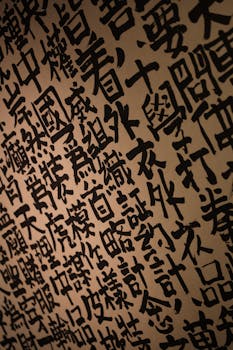Welcome to the world of Mandarin Chinese, a language steeped in history, culture, and a unique writing system. One essential aspect of mastering Mandarin is understanding stroke order, a set of rules dictating the sequence in which the strokes of a Chinese character are written. Mastering Mandarin stroke order is not just about writing characters correctly—it's about immersing yourself in a rich tradition and enhancing your comprehension and memorization of each character.
Mandarin stroke order is akin to a rhythmic dance, each move carefully choreographed to create a beautiful, coherent piece of art. It's a process that provides structure and good form to Chinese characters, and with practice, can feel satisfying and surprisingly intuitive. But what exactly is stroke order, and why is it so important in the world of Mandarin Chinese? Let's dive into the fascinating universe of Mandarin stroke order and explore the essential techniques to perfect your Chinese writing.
Importance of Learning Mandarin Stroke Order
Mastering Mandarin stroke order is not just about getting the aesthetics of your characters right; it's a key to unlocking your full potential in learning the language. Here's why.
Enhancing Memorization and Retention
Learning Mandarin is not just about reading and speaking; it's also about writing. While it's true that in this digital age, we often type more than we write, the act of physically writing Chinese characters by hand provides tangible cognitive benefits. Writing Chinese characters engages your brain, deepens your comprehension of each character's structure and meaning, and more importantly, improves your recall. When you write the characters on paper, you're not just learning the strokes; you're committing them to memory.
Developing Muscle Memory
In the world of language learning, repetition is crucial. When you regularly practice Chinese stroke order, you're not just familiarizing yourself with the strokes; you're creating muscle memory. Professor Victor Mair from the University of Pennsylvania describes writing Chinese characters as a "highly neuro-muscular act," and the more you write, the more you "etch the characters into your nerves and muscles." This muscle memory can aid in faster, more effortless writing in the long run.
Handwriting Recognition in Digital Dictionaries
In the digital world, stroke order is still very much relevant, particularly when it comes to handwriting recognition. Popular digital dictionary apps like Pleco allow you to draw an unfamiliar character with your finger to look it up. But, if your stroke order is incorrect, the app may struggle to recognize the character. On the other hand, if you get the stroke order right, the app can identify the character instantly, even if your handwriting isn't perfect.
In conclusion, learning Mandarin stroke order is not an optional extra; it's an integral part of your Mandarin learning journey. Whether you're writing on paper or a digital screen, getting the stroke order right can give you that extra edge in your language learning journey.

Understanding the Basic Strokes in Chinese
Think of Chinese characters as a puzzle, made up of smaller pieces. Each piece is a stroke and understanding them is like knowing how to fit these pieces together. Now, let's delve into the world of Chinese strokes and their classifications.
The 8 Basic Strokes in Chinese
The Chinese language is an art, and like any art form, it's built on fundamental elements. In the case of Chinese, these elements are often referred to as the 8 basic strokes: 点, 横, 竖, 撇, 捺, 提, 钩, 弯. These strokes form the backbone of nearly every Chinese character you'll encounter. Mastering these 8 basic strokes will provide you with the necessary skills to write a majority of Chinese characters accurately and with ease.
The 5 Fundamental Strokes in Chinese
While the 8 basic strokes provide a comprehensive view of Chinese character writing, you can simplify your learning further by focusing on the 5 fundamental strokes. These strokes are 横, 竖, 撇, 点, 折, which translates to Horizontal, Vertical, Downward Left, Dot, and Bend. Focusing on these 5 strokes can help you group the 26 derivative strokes and make your learning process more manageable.
The 26 Derivative Strokes in Chinese
In addition to the basic and fundamental strokes, there are also 26 derivative strokes. These strokes are variations and combinations of the 8 basic strokes, and they add complexity and detail to Chinese characters. Understanding these strokes will give you a deeper insight into the structure of Chinese characters and significantly enhance your writing skills.
Remember, the key to mastering these strokes lies in constant practice. Writing Chinese characters is not just about memorizing the stroke order; it's about training your hand to follow the rhythm and flow of writing each character. The more you practice, the more natural it will feel, and the more beautiful your characters will look. So keep practicing, and watch as the art of Chinese character writing unfolds before you.

The 12 Rules of Chinese Stroke Order
Unleashing the beauty of Mandarin writing lies in the mastery of Chinese stroke order. These aren't arbitrary rules, but a structured system designed to make writing Chinese characters a rhythmic dance rather than a daunting task. Let's delve into the twelve essential rules that form the backbone of Mandarin stroke order.
Writing from Top to Bottom
This is the first rule of thumb in Chinese stroke order. Start from the top of the character and make your way down. Just like reading a book, your brush or pen takes a similar journey.
Writing from Left to Right
After the top-down approach, the second rule is to write from left to right. This might feel like second nature to many learners, especially those who are already accustomed to Latin-based languages.
Drawing Horizontal Before Vertical Strokes
When a character has both horizontal and vertical strokes, remember to draw the horizontal lines first. This rule ensures a smooth transition in your writing.
Drawing Diagonals Right to Left Before Left to Right
For characters with diagonal strokes, draw the diagonals from right to left before those from left to right. It might sound complicated at first, but with a little practice, it becomes straightforward.
Drawing Outside Before Inside
When it comes to characters that are partially enclosed, the rule is to draw the outside before the inside. This helps maintain the shape and symmetry of the character.
Drawing Inside Before Bottom Enclosing
This rule, which seems to contradict the previous one, only applies to characters enclosed from the bottom or bottom left. For these characters, you'll need to draw the inside strokes before the outside ones.
Drawing Center Verticals Before Outside "Wings"
For characters with "wings", the center vertical stroke comes first before the exterior details. This rule helps maintain the balance and proportion of the character.
Cutting Strokes Last
The cutting strokes, which run through the character, are drawn last. This rule is similar to drawing horizontal strokes before vertical ones, and it's essential for maintaining the symmetry of the character.
Drawing Left Vertical Before Enclosing
When you have characters that are entirely enclosed, draw the left vertical stroke first, then the enclosing component. This rule ensures the character's form is maintained.
Drawing Top or Upper-Left Dots First
Despite breaking the top-to-bottom and left-to-right rules, the dots at the top or upper left of a character are drawn first. This rule is crucial in maintaining the integrity and aesthetics of the character.
Dots on the Inside or Upper-Right are Drawn Last
Acting as a counter to the previous rule, dots on the inside or upper-right of a character are written after every other stroke. This specific placement of dots is crucial to the character's overall appearance and recognition.
Character-spanning Strokes Last
The last rule in the Mandarin stroke order is that character-spanning strokes come last. These strokes, which run through the entire character, are drawn after all other strokes, completing the character's structure.
Mastering these rules is a crucial step in your Mandarin learning journey. With practice and patience, these rules will become second nature, making your Mandarin writing more fluent and aesthetically pleasing. And remember, as you practice these rules, you're not just learning to write—you're immersing yourself in a vibrant and ancient art form.

Techniques to Memorize Chinese Strokes
Unraveling the labyrinth of Mandarin strokes can be a daunting task, but with the right techniques, this seemingly insurmountable task turns into an exhilarating journey. Here are some proven methods that can aid you in understanding and memorizing the strokes and their order.
Learning the Correct Stroke Order
The stroke order in Chinese writing isn't just a convention—it's the backbone of learning Mandarin. As mentioned earlier, writing Chinese characters in the correct order enhances memorization, helps develop muscle memory, and aids in handwriting recognition on digital platforms. So make sure you give due importance to the correct stroke order.
Learning Radicals
Radicals are the building blocks of Chinese characters. They are akin to roots in English vocabulary, giving you a hint about the character's meaning or pronunciation. Mastering radicals is a powerful shortcut to understanding and remembering Chinese characters. It's like unlocking a secret code that suddenly makes a myriad of complex characters comprehensible.
Making Learning Characters Fun
Who said learning Mandarin strokes has to be boring? Turn it into a game or challenge. Use color-coding to differentiate stroke types, draw funny images around characters, or create mnemonic devices. The more enjoyable the learning process, the more likely you are to stick with it.
Avoiding Random Word Lists
When learning Mandarin, it's tempting to memorize long lists of random characters. However, this approach rarely leads to long-term retention. Instead, focus on learning characters in context—through sentences, stories, or conversations. This way, you're not just learning strokes and characters, but also how they function in real-life communication.
Integrating Character Writing with the Rest of the Chinese Language
Don't compartmentalize character writing as a separate part of your Mandarin learning. Integrate it with your reading, speaking, and listening practice. When you learn a new word, practice writing it. When you hear a phrase, try to visualize the characters in your mind. This holistic approach can significantly boost your overall Mandarin proficiency.
Creating Personal Techniques
Each learner is unique, and what works for one person might not work for another. Feel free to experiment and create your own techniques. Maybe you find it helpful to write a character multiple times in a row, or perhaps you prefer drawing a character in the air with your finger. The key is to find what works best for you and stick with it.
Writing Characters the Old-Fashioned Way
Despite the allure of digital learning tools, nothing beats the old-fashioned way of writing characters by hand. Writing engages different cognitive processes, leading to deeper understanding and better retention of characters. So, put pen to paper and practice writing Chinese characters the traditional way.
Mastering Mandarin stroke order is not a sprint; it's a marathon. But with these techniques in your arsenal, you're well on your way to becoming a proficient writer of Mandarin characters. Remember, every stroke you make is a stroke of progress, bringing you one step closer to perfect Mandarin writing.

Using Traverse App for Learning Mandarin Stroke Order
When it comes to mastering Mandarin stroke order, there's no need to go it alone. With the right tools at your disposal, this process can become simpler, more efficient, and even enjoyable. One such tool is the Traverse app, designed to transform your Chinese learning journey into an immersive, engaging, and fruitful venture.
Partnering with Mandarin Blueprint
A significant strength of the Traverse app lies in its partnership with Mandarin Blueprint. This alliance brings together the power of mnemonic techniques, storytelling, and gamified lessons, ultimately making the process of learning Mandarin stroke order a breeze. The synthesis of Traverse's advanced features and Mandarin Blueprint's innovative approach provides a comprehensive learning experience, allowing you to grasp Mandarin stroke order with ease.
Importing Anki Decks for Continued Learning
If you've been using Anki, a flashcard app that follows the spaced repetition system, you'll find the transition to the Traverse app seamless. Traverse allows the importation of your Anki decks, enabling you to continue your Mandarin learning journey without disruption. This feature combines the convenience of using familiar study material with the advanced learning techniques of Traverse, ensuring your progress in mastering Mandarin stroke order remains unhindered.
Utilizing Mind Mapping, Spaced Repetition Flashcards, and Connected Note-Taking
Traverse goes beyond traditional learning methods by integrating mind mapping, spaced repetition flashcards, and connected note-taking. Mind mapping helps visualize the connections between different Chinese characters, aiding in memory retention and understanding. Spaced repetition flashcards, on the other hand, uses increasing intervals of time between subsequent reviews of previously learned material, a scientifically proven method to enhance language learning. Connected note-taking allows you to link related information, creating a comprehensive learning environment that encompasses all aspects of Mandarin stroke order.
In conclusion, the Traverse app, in partnership with Mandarin Blueprint, provides a robust platform for mastering Mandarin stroke order. By leveraging the strengths of these platforms, you're not only learning Mandarin stroke order but immersing yourself in a complete learning ecosystem that propels you towards Chinese fluency. So, why wait? Start your Mandarin journey today and experience the transformative power of Traverse and Mandarin Blueprint firsthand.
Conclusion: Mastering Mandarin Stroke Order for Perfect Writing
Mastering Mandarin stroke order is not just about penmanship. It's a fundamental aspect of learning the Chinese language that impacts your recognition, memorization, and understanding of Chinese characters. This process might seem daunting initially, but with the right tools and techniques, you can seamlessly integrate it into your language learning journey.
By adhering to the 12 basic rules of stroke order, starting with writing from top to bottom and left to right, and finishing with drawing character-spanning strokes last, you'll soon start to see patterns and rules that will make this seemingly complex task much more manageable.
Employing various techniques like learning radicals, avoiding random word lists, and making learning fun can greatly enhance your stroke order skills. Remember, practice is key. The more you write, the more natural these rules will feel, and the faster you'll be able to write Chinese characters.
The Traverse app, in partnership with Mandarin Blueprint, offers a comprehensive and efficient approach to learning Mandarin stroke order. Its features like mind mapping, spaced repetition flashcards, and connected note-taking, combined with the ability to import your Anki decks, ensure that you're learning and reviewing characters at the optimal time for long-term retention.
To conclude, mastering Mandarin stroke order is an essential skill for perfect writing. It's a journey that requires patience, practice, and the right set of tools. Equip yourself with the Traverse app and the Mandarin Blueprint method, and you'll be writing beautiful, accurate Chinese characters in no time. Embark on this journey today, and watch your command of the Chinese language soar to new heights!

